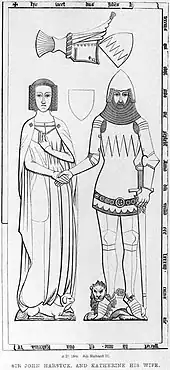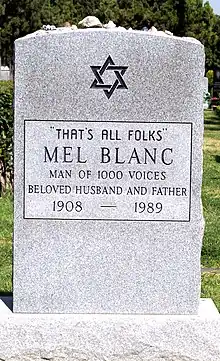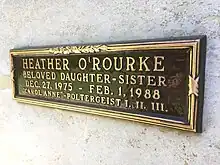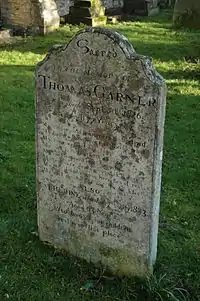Epitaph
An epitaph (from Ancient Greek ἐπιτάφιος (epitáphios) 'a funeral oration'; from ἐπι- (epi-) 'at, over', and τάφος (táphos) 'tomb')[1][2] is a short text honoring a deceased person. Strictly speaking, it refers to text that is inscribed on a tombstone or plaque, but it may also be used in a figurative sense. Some epitaphs are specified by the person themselves before their death, while others are chosen by those responsible for the burial. An epitaph may be written in prose or in poem verse.

Most epitaphs are brief records of the family, and perhaps the career, of the deceased, often with a common expression of love or respect—for example, "beloved father of ..."—but others are more ambitious. From the Renaissance to the 19th century in Western culture, epitaphs for notable people became increasingly lengthy and pompous descriptions of their family origins, career, virtues and immediate family, often in Latin. Notably, the Laudatio Turiae, the longest known Ancient Roman epitaph, exceeds almost all of these at 180 lines; it celebrates the virtues of an honored wife, probably of a consul.
Some are quotes from holy texts, or aphorisms. One approach of many epitaphs is to "speak" to the reader and warn them about their own mortality. A wry trick of others is to request the reader to get off their resting place, inasmuch as the reader would have to be standing on the ground above the coffin to read the inscription. Some record achievements (e.g., past politicians note the years of their terms of office). Nearly all (excepting those where this is impossible by definition, such as the Tomb of the Unknown Soldier) note name, year or date of birth, and date of death. Many list family members and the relationship of the deceased to them (for example, "Father / Mother / Son / Daughter of").
Linguistic distinctions
In English, and in accordance with the word's etymology, the word "epitaph" refers to a textual commemoration of a person, which may or may not be inscribed on a monument. In many European languages, however, the meaning of the word (or its close equivalent) has broadened to mean the monument itself, specifically a mural monument or plaque erected in a church, often close to, but not directly over, a person's place of burial.[3] Examples include German Epitaph; Dutch epitaaf; Hungarian epitáfium; Polish epitafium; Danish epitafium; Swedish epitafium; and Estonian epitaaf.
History
The history of epitaphs extends as far back as the ancient Egyptians and have differed in delivery.[4] The ancient Greeks utilised emotive expression, written in elegiac verse, later in prose.[4] Ancient Romans' use of epitaphs was more blunt and uniform, typically detailing facts of the deceased – as did the earliest epitaphs in English churches.[4] "May the earth lie light upon thee" was a common inscription for them.[4] Due to the influence of Roman occupiers, the dominant language of epitaphs was Latin, evidenced by the oldest existing epitaphs in Britain. French and English came into fashion around the 13th and 14th centuries, respectively.[4]
By the 16th century, epitaphs had become more literary in nature and those written in verse were involved in trade.[4] In America and Britain, comedic epitaphs are common in the form of acrostics, palindromes, riddles, and puns on names and professions – Robert Burns, the most prolific pre-Romantic epitaphist, wrote 35 pieces, them being largely satirical.[4][5] The rate of literary epitaphs has been historically overshadowed by "popular sepulchral inscriptions which are produced in countless numbers at all time"; "strictly literary" epitaphs were most present during the start of the Romantic period.[5]
The Lake Poets have been credited with providing success to epitaph-writing adjacent to that of poetry significance – Robert Southey, in focusing simultaneously upon transience and eternity, contributed substantially.[5] General interest for epitaphs was waning at the cusp of the 19th century, in contrast to a considerable burgeoning intellectual interest.[5] Critical essays had been published before on the matter, possibly contributing towards its flourishing in the latter half of the 18th century.[5] Epitaphs never became a major poetic form and, according to Romantic scholar Ernest Bernhardt-Kabisch, they had "virtually disappeared" by 1810. "The art of the epitaph was largely lost in the 20th century", wrote the Encyclopedia Britannica.[4][5]
Format
Sarcophagi and coffins were the choice of ancient Egyptians for epitaphs; brasses was the prominent format for a significant period of time.[4] Epitaphs upon stone monuments became a common feature by the Elizabethan era.[4]
In England
Medieval era

Stock phrases or standard elements present in epitaphs on mediaeval church monuments and ledger stones in England include:
- Hic jacet.. (here lies...)
- ... cuius animae propitietur deus amen (generally abbreviated to cuius aie ppitiet ds ame with tildes indicating the omitted letters) ("whose soul may God look upon with favour Amen")
- Memoriae sacrum ... / MS ("Sacred to the memory (of) ...")
Modern era
- Requiescat in pace / RIP ("may he rest in peace")
Notable examples
Poets, playwrights and other writers
While you live, shine
have no grief at all
life exists only for a short while
and Time demands his due.
This is my father's crime against me, which I myself committed against none.
Good frend for İesvs sake forebeare,
To digg the dvst encloased heare.
Bleste be yͤ man yͭ spares thes stones,
And cvrst be he yͭ moves my bones.
(In modern spelling):
Good friend, for Jesus's sake forbear
To dig the dust enclosed here.
Blessed be the man that spares these stones,
And cursed be he that moves my bones.
Here lies One whose Name was writ in Water
Cast a cold eye
On life, on death.
Horseman, pass by!
Sleep after toyle, port after stormie seas,
Ease after warre, death after life, does greatly please.
Homo sum! the adventurer
Against you I will fling myself, unvanquished and unyielding, O Death!
Statesmen
Oh God (Devanagari: हे राम)
Mathematicians
I've finally stopped getting dumber.
(Hungarian: Végre nem butulok tovább.)
We must know. We will know.
(German: Wir müssen wissen. Wir werden wissen.)
Soldiers
Go tell the Spartans, stranger passing by
that here, obedient to their law, we lie.
Here sleeps at peace a Hampshire Grenadier
Who caught his early death by drinking cold small beer.
Soldiers, be wise at his untimely fall,
And when you're hot, drink strong or none at all.
To save your world you asked this man to die:
Would this man, could he see you now, ask why?
When you go home, tell them of us and say,
For your tomorrow, we gave our today
There is borne an empty hearse
covered over for such as appear not.
Heroes have the whole earth for their tomb.
Entertainers
And the beat goes on.
That's all folks!
I told you I was ill.
(Irish: Dúirt mé leat go raibh mé breoite.)
Activists
Free at last, Free at last,
Thank God Almighty
I'm Free at last.
Other
He never killed a man that did not need killing.
Monuments with epitaphs

 Grave of W. B. Yeats; Drumecliff, Co. Sligo
Grave of W. B. Yeats; Drumecliff, Co. Sligo Lengthy epitaph for Johann Wauer (d. 1728), a German pastor, concluding with a short Biblical quotation
Lengthy epitaph for Johann Wauer (d. 1728), a German pastor, concluding with a short Biblical quotation The epitaph on voice actor Mel Blanc's tombstone
The epitaph on voice actor Mel Blanc's tombstone Inscription at Heather O'Rourke's crypt
Inscription at Heather O'Rourke's crypt Ezzatollah Sahabi, Glory of Iran and his patriotic daughter Haleh
Ezzatollah Sahabi, Glory of Iran and his patriotic daughter Haleh A folksy epitaph to an English village blacksmith in Houghton, Cambridgeshire
A folksy epitaph to an English village blacksmith in Houghton, Cambridgeshire The gravestone of comedian, writer and actor Spike Milligan showing the notable epitaph
The gravestone of comedian, writer and actor Spike Milligan showing the notable epitaph Grave of Mary Kay Bergman, at Forest Lawn Memorial Park (Hollywood Hills). It features etchings of characters she voiced on South Park.
Grave of Mary Kay Bergman, at Forest Lawn Memorial Park (Hollywood Hills). It features etchings of characters she voiced on South Park.
In music
In a more figurative sense, the term may be used for music composed in memory of the deceased. Igor Stravinsky composed in 1958 Epitaphium for flute, clarinet and harp. In 1967 Krzysztof Meyer called his Symphony No. 2 for choir and orchestra Epitaphium Stanisław Wiechowicz in memoriam. Jeffrey Lewis composed Epitaphium – Children of the Sun for narrator, chamber choir, piano, flute, clarinet and percussion. In 1969, King Crimson released the song Epitaph, giving a reference to epitaphs within the song. Bronius Kutavičius composed in 1998 Epitaphium temporum pereunti. Valentin Silvestrov composed in 1999 Epitaph L.B. (Епітафія Л.Б.) for viola (or cello) and piano. In 2007 Graham Waterhouse composed Epitaphium for string trio as a tribute to the memory of his father William Waterhouse. The South African poet Gert Vlok Nel wrote an (originally) untitled song, which appeared on his first music album "Beaufort-Wes se Beautiful Woorde" as "Epitaph", because his producer Eckard Potgieter told him that the song sounded like an epitaph. David Bowie's final album, Blackstar, released in 2016, is generally seen as his musical epitaph, with singles "Blackstar" and "Lazarus" often singled out.
See also
References
- ἐπιτάφιος. Liddell, Henry George; Scott, Robert; A Greek–English Lexicon at the Perseus Project
- "epitaph". Online Etymology Dictionary. Retrieved 18 March 2012.
- Mérai, Dóra (2015). "Stones in floors and walls: commemorating the dead in the Transylvanian Principality". In Dumitran, Daniel; Rotar, Marius (eds.). Places of Memory: cemeteries and funerary practices throughout the time. Annales Universitatis Apulensis: Series Historica. Vol. 19. Cluj-Napoca: Editura Mega. pp. 151–174 (153–162). ISSN 1453-9306.
- "Epitaph | poetic form". Encyclopedia Britannica. 20 June 2019. Retrieved 5 August 2021.
- Bernhardt-Kabisch, Ernest (1967). "The Epitaph and the Romantic Poets: A Survey". Huntington Library Quarterly. 30 (2): 113–146. doi:10.2307/3816994. ISSN 0018-7895. JSTOR 3816994.
- Landels, John G. 1999. Music in Ancient Greece and Rome. London and New York: Routledge. ISBN 9780415167765 (cloth); ISBN 9780415248433 (pbk); ISBN 9780203042847 (ebook)
- Blankinship, Kevin (20 September 2015). "An Elegy by al-Ma'arri". Jadaliyya. Retrieved 4 May 2020.
- Photograph of William Shakespeare's grave, 3 June 2007
- Charles Dickens (1893). Dickens' Dictionary Of The Thames. p. 269.
- Woolf, Virginia (1931), The Waves, Berlin: Harcourt
- "The Man Who Loved Only Numbers". archive.nytimes.com. Retrieved 28 July 2022.
- "Göttingen Stadtfriedhof Grab David Hilbert". Wikimedia.
- "Famous Epitaph on Unknown Soldier tomb stone". Famousquotes.me.uk. Retrieved 18 March 2012.
- Thucydides (1843). "History of the Peloponnesian War 2.34.3". In Molesworth, William (ed.). The English works of Thomas Hobbes of Malmesbury. Vol. VIII. Thomas Hobbes (translator). London: John Bohn. p. 188. Available online at the Perseus Project.
- Thucydides (1910). "2.43.3". The Peloponnesian War. Translated by Richard Crawley. London, New York: J. M. Dent; E. P. Dutton. Available online at the Perseus Project.
- "Milligan gets last laugh on grave". BBC News Online. 24 May 2004. Retrieved 8 June 2015.
Bibliography
- Bertrand, Régis (2005). "Que de vertus: Les épitaphes édifiantes des débuts du XIXe siècle". In Bertrand, Régis; Carol, Anne; Pelen, Jean-Noël (eds.). Les narrations de la mort. Aix-en-Provence: Publications de l'Université de Provence. pp. 241–255. ISBN 2853996131.
- Guthke, Karl S. (2003). Epitaph Culture in the West: variations on a theme in cultural history. Lewiston, NY: Mellen. ISBN 0773467858.
- Scodel, Joshua (1991). The English Poetic Epitaph: commemoration and conflict from Jonson to Wordsworth. Ithaca, NY: Cornell University Press. ISBN 0801424828.
- Vidor, Gian Marco (2014). "Satisfying the mind and inflaming the heart: emotions and funerary epigraphy in nineteenth-century Italy". Mortality. 19 (4): 342–360. doi:10.1080/13576275.2014.921667. S2CID 144222277.
External links
- Imperial War Museum. "What is the Kohima Epitaph?". archive.iwm.org.uk. Archived from the original on 30 December 2014. Retrieved 4 April 2013.
- Kohima Epitaph